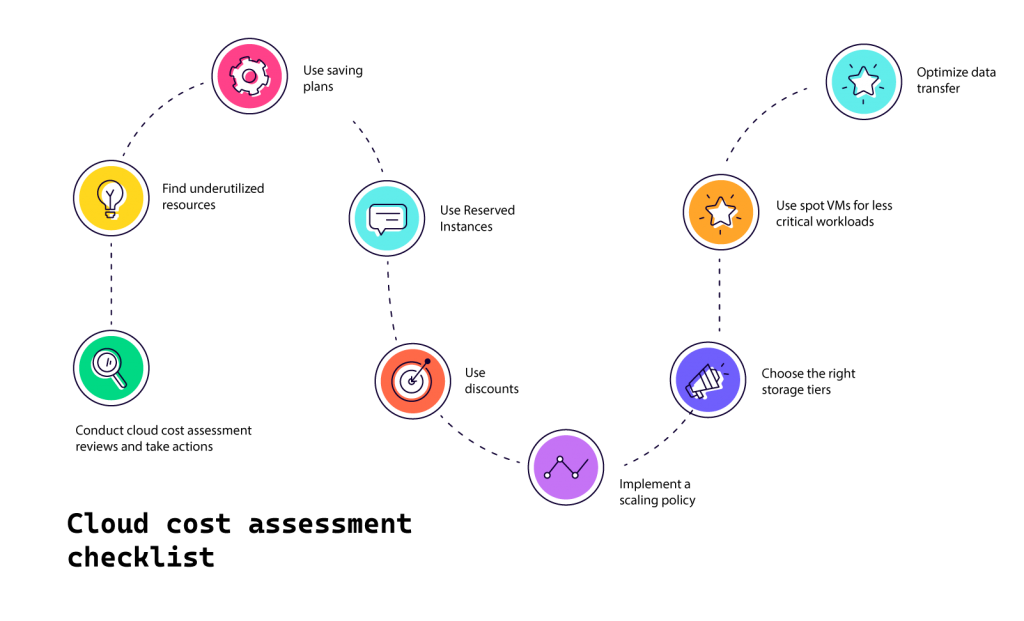
31 Oct Cloud cost optimization: A complete guide
Cloud cost optimization: A complete guide
“94% of enterprises are overspending in the cloud”
-HashiCorp- Forrester Report,2022
Are you overspending on the cloud? Is your cloud spending aligned with your business goals and adapting with growth? If you do not have a proper cloud optimization strategy in place, chances are you are paying much more than you need to and may not be always investing in the right resources.
The most common factor contributing to overspending on cloud is underused and over-provisioned resources as well as a lack of skills. How can you make sure that you are not wasting the cloud resources and spending more than you need to? Let’s find out.
What is cloud optimization and why is it important?
Cloud optimization involves assigning the right resources to workloads and applications to achieve efficiency in terms of cost and performance. Cloud cost optimization can be simply explained as delivering the maximum business value at the minimum price.

17 cloud optimization techniques and best practices
The cloud optimization process requires continuous monitoring, reviewing, and analyzing the current usage patterns and optimizing them for maximum use of resources and reducing the cost required. Here are 17 cloud optimization best practices to help you.
1. Analyze your cloud bills and cost
Cloud bills are often detailed and give you an idea of the cost of cloud services. By analyzing the resources that you are spending your money mostly on, you can prioritize, optimize and make necessary changes. A practice of reviewing and analyzing cloud bills will help you make informed decisions and make savings.
2. Create budget goals
Creating a budget can help everyone understand the budget goals and ensure cost control. When deciding on the budget for each project, make sure that all the leads and executives communicate well. Determine the type of plans, and tradeoffs with requirements such as speed and resiliency. Setting up a monthly budget can help you in managing overall spending effectively and optimize cloud spending. Also, keep in mind that these spending may differ based on the needs of the organization.
3. Monitor and right–size compute instances
Selecting the right instance type can be overwhelming with different options available in the cloud. Choosing incorrect instance sizes, families, and idle instances that developers spin up and forget about often contributes to hefty cloud bills. So, proactively monitoring compute resources on the cloud and optimizing them is a good practice for ensuring optimal usage of the resources.
4. Look out for anomalies
Monitor spending patterns continuously and looks out for sudden spikes and unexpected spending. There might be many instances when your cloud spending goes over the set budget. The key is to investigate and find the cause. A sudden spike can be due to the launching of a new set of virtual machines, resources being priced higher than expected or some new resources created causing an unexpected spike in cost in another service. You can find the root cause and resolve the anomaly to optimize cost.
5. Find underutilized resources
There are many services and tools that can help you with modernizing applications and you can choose the ones you need based on the cloud platforms and modernization process you are following. Azure, AWS, and GCP offer their own app migration toolkits. Choose third-party tools carefully and get all the resources that you need to modernize and migrate applications from start to end.
6. Find idle computing resources
When an instance with low CPU usage like 10% is billed for full usage or 100% you are wasting significant compute power and contributing to spiralling cloud bills. Finding idle resources and consolidating them can help you save costs. You don’t have to save up resources to handle spikes because you can leverage features of the cloud such as autoscaling, load balancing, and other on-demand options.
7. Automate provisioning of infrastructure
Leverage infrastructure as code (IaC) tools. Fully automate infrastructure provisioning and management by making it a part of the Continuous Integration Continuous Deployment CI/CD pipeline.
8. Optimize software licensing costs
Software licensing spend is one of the important costs whether you are on–premise or on the cloud. If you are not keeping track of these licenses, you might be paying for unused ones. Monitor and keep track of unused and idle software licenses to optimize spending.
9. Make use of saving plans and reserved instances
There are many pricing options and compute options on the cloud like reserved instances, spot instances, savings plans, discounts, on-demand, and spot instances. Build a strategic purchasing plan by monitoring usage and requirements.
Reserved instances (RIs) are long-term investments and provide large discounts based on upfront costs and time. When choosing reserved instances, analyze past usage patterns and prepare for future usage accordingly. Reserved instances can get you around 75% cost savings and is an important part of cloud cost optimization.
10. Use spot instances effectively
Spot instances are available at low prices, and you can buy them at the last minute. But the downside is that they are not always available and are sold out quickly. So, they may be unreliable. Using spot instances for immediate jobs that are not critical or time-consuming can help you save computing power and cost.
11. Minimize data transfer fees
Migrating data and transferring data between platforms and regions can be costly. Cloud vendors charge a fee for transferring data and you can save on it by avoiding unnecessary data transfers. You can also evaluate the transfer fees and take steps to minimize frequent data transfer requirements. You can compare the cost of secure data transfer methods such as using physical data transfer devices like AWS Snowball and Azure Databox to using dedicated network connection services like AWS Direct Connect, Google Cloud Interconnect, or Azure ExpressRoute.
12. Deciding on single or multi-cloud
More and more businesses prefer multi-cloud architecture to avoid vendor lock-in and to get other benefits. But you need to carefully evaluate if a single cloud consulting service provider can provide the resources that your organization requires or whether you need multiple vendors. When spending on a single vendor, you can get higher tiers with greater discounts.
13. Integrate cloud cost optimization to SDLC
Cost should be an important part of decision-making all through the software development lifecycle. From planning to deployment and operations, you need to keep track of the spending as engineering decisions have costs associated with it.
14. Go cloud- native
Cloud-native design helps you leverage cloud-specific capabilities such as implementing a pay-as-you-go pricing model with auto-scaling. Make sure that your design matches your organization’s priorities and requirements and balances cost and performance at the same time. Organizations also modify their infrastructure than building it from scratch.
15. Use visual tools to analyze the cloud usage
Data visualization tools make it easier for you to understand the cloud environment. Popular data visualization tools like heatmaps help you to identify hotspots and adjust the usage accordingly. For example, by understanding the peaks and troughs of computing usage, you can decide whether to shut down development servers during the weekend.
16. Create a culture of transparency and awareness
Adopting the cloud requires a cultural shift in the organization and cross-functional cost awareness can help in understanding cloud spending across different departments. This will let teams make smarter decisions when using cloud resources.
17. Use the right storage options
Based on whether you are looking for long-term storage or for immediate use, storage tiers differ. The cost of each storage tier varies with the size of the data and the speed of retrieval. Choosing the right storage tier can save you money. There are also intelligent cloud optimization tools that can help you choose the right tiers.

Cloud cost optimization with Nuvento
Successful organizations always implement good practices and when it comes to the cloud, you need to have an in-depth idea of your cloud environment and changing needs to make full use of the cloud environment. At Nuvento, we help organizations reap the full benefit of the cloud while optimizing their cloud costs with our cloud-managed services. We help our clients balance cost and performance from every step, migration to operation by prioritizing their current and future needs and help drive growth.
